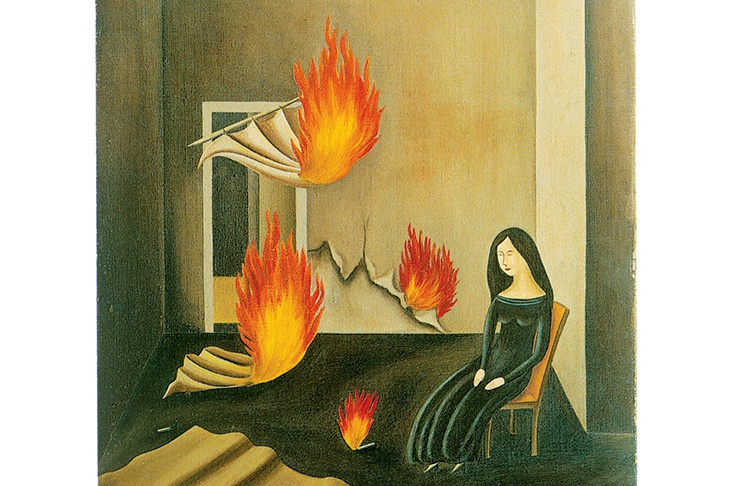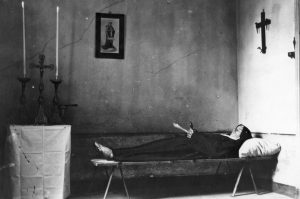Those with long enough memories may remember Desmond Morris as the presenter of the hit ITV children’s programme of Zoo Time in the late 1950s and early 1960s. Or perhaps as the author of the 1968 bestseller The Naked Ape, in which he argued that, beneath our sophisticated veneer, humans are nothing more than primates.
Now aged 90, he has written an uproariously funny book on the ostensibly unlikely subject of the Surrealists. I say ‘ostensibly’ because, before becoming a successful zoologist, Morris was actually a painter and even had a joint exhibition in London with Joan Miró.
In The Lives of the Surrealists he takes on the role of a latter-day Vasari, penning mini-biographies of 32 artists who were associated with Surrealism. Bringing his background in animal biology to bear, Morris holds nothing back when it comes to his subjects’ bestial urges. It’s their unbridled sex lives, not their paintings, that interest him.
The artists are ordered alphabetically — such that on the first page of the first entry we read how Eileen Agar enjoyed the challenge of ‘making love standing up in a hammock’. Roland Penrose, meanwhile, preferred bondage. The art collector Peggy Guggenheim, Penrose’s lover in the 1930s, complained: ‘It was extremely uncomfortable to spend the night… shackled to a bedpost. But spending it with Penrose, that was the only way.’
Morris’s introduction to this book actually leads us to expect something different, and more scholarly. He considers Surrealism’s origins in Paris as a rebellion against the rationalist, orthodox society that had just effected the slaughter of the first world war. It began predominantly as a literary movement, but its founder, André Breton, soon realised that art offered the best route to international significance, as paintings transcend linguistic barriers.
Morris suggests that the rich diversity of artists under Surrealism’s umbrella was another reason for its success: from Magritte (whose well-planned compositions featured realistically portrayed elements irrationally juxtaposed) to Miró (who let his imagination run riot and, essentially, made up his semi-abstract paintings on the spot).
Having used the introduction to get the serious stuff out of the way, Morris then dives into the biographies with relish. His anecdotes are all told with a dry but good-natured humour, serving to ridicule but never savage his subjects when their antics turned odd. (The author knew a number of these artists personally, his brief stint as a Surrealist overlapping with the end of their careers.)
We learn of the time Marlene Dietrich arrived in Paris demanding a date with Alberto Giacometti. The sculptor obliged and promptly fell in love. He failed to show up for a second meeting, however, after his jealous prostitute-lover, Caroline, got wind of things and issued Giacometti with a threat: unless he forgot about Dietrich he’d have one of Caroline’s Montparnasse gangster clients to answer to.
Salvador Dalí was ‘without question the most skilful and accomplished of the Surrealists’ — though one wonders whether Morris’s opinion isn’t based partly on the fact that Dalí offers the juiciest case of sexual deviance. The Spaniard is said to have had a ‘lifelong obsession with masturbation’, and engaged in penetrative intercourse only once. Apparently, he and his wife Gala got their kicks by rounding up a group of young men, the most attractive of whom she would seduce, while he looked on, pleasuring himself.
Occasionally one stops to wonder how on earth Morris knows so much intimate information — but not for long, as the narratives move on apace. We learn of Leonor Fini’s habit of leaving her lovers with indelible claw marks; and of the time Yves Tanguy’s wife attacked one of his mistresses with a fish.
To be fair, the tales aren’t completely frivolous. The outbreak of the second world war — in which countless Surrealists fled Europe for the Americas, after their movement was declared degenerate by the Nazis — ensures a certain tension.
I suppose one might question the inclusion of a few artists in Morris’s line-up, given how tentative their link to Surrealism was: Picasso and Bacon are the obvious examples, especially as their life stories are so well known already. But this is compensated for by a number of lesser known figures, such as the Austrian Wolfgang Paalen, who met an aptly surreal end: being eaten by wild pigs in a remote part of southern Mexico.
According to another of Morris’s subjects, Méret Oppenheim, the Surrealists were ‘all a bunch of bastards’. And certainly there are times when treatment of their nearest and dearest seems callous: as if the Surrealist tag offered a right to behave beyond societal norms. In the main, however, these figures make for highly entertaining company. It’s just a wonder they found time to do any painting.


















